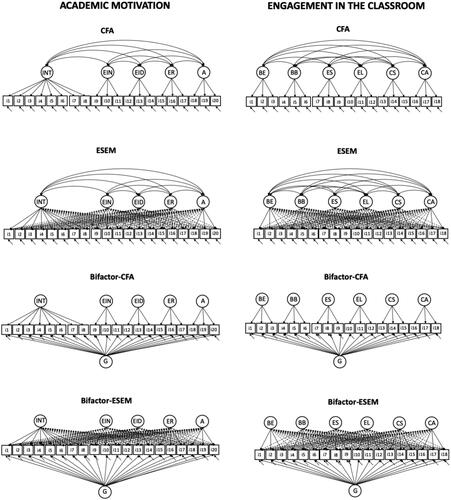Figures & data
Figure 1. Schematic representation of the potential predictive models of academic motivation predicting engagement in the classroom.
Note. G: Global factor; INT: Intrinsic motivation; EIN: Extrinsic-identified regulation; EID: Extrinsic-introjected regulation. ER: External regulation. A: Amotivation. BE: Behavioral engagement: Effort/attention; BB: Behavioral engagement: Boredom/distraction; ES: Emotional engagement: Social; EL: Emotional engagement: Learning; CS: Cognitive engagement: Strategies; CA: Cognitive engagement: Autoregulation.

Table 1. Sample descriptive statistics (N = 4047).
Figure 2. Alternative measurement models of academic motivation and engagement in the classroom.
Note. CFA: Confirmatory Factor Analysis. ESEM: Exploratory Structural Equation Model; G: Global factor; INT: Intrinsic motivation; EIN: Extrinsic-identified regulation; EID: Extrinsic-introjected regulation. ER: External regulation. A: Amotivation. BE: Behavioral engagement: Effort/attention; BB: Behavioral engagement: Boredom/distraction; ES: Emotional engagement: Social; EL: Emotional engagement: Learning; CS: Cognitive engagement: Strategies; CA: Cognitive engagement: Autoregulation.

Table 2. Alternative measurement models.
Table 3. Standardized factor loadings (λ) and uniquenesses (δ) of the bifactor-CFA and bifactor-ESEM solutions: academic motivation.
Table 4. Standardized factor loadings (λ) and uniquenesses (δ) of the partial bifactor-CFA solution: student engagement.
Table 5. Latent associations between academic motivation and school engagement.
Figure 3. Result summary from the final predictive model (partial mediation).
Note. Only statistically significant paths are shown (p ≤ .05); positive paths are represented by full arrows whereas negative paths are represented by dotted-arrows; G: Global factor; INT: Intrinsic motivation; EIN: Extrinsic-identified regulation; EID: Extrinsic-introjected regulation. ER: External regulation. A: Amotivation. BE: Behavioral engagement: Effort/attention; BB: Behavioral engagement: Boredom/distraction; ES: Emotional engagement: Social; EL: Emotional engagement: Learning; CS: Cognitive engagement: Strategies; CA: Cognitive engagement: Autoregulation.

